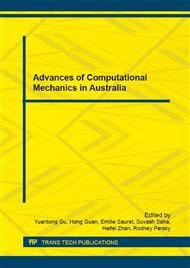[1]
Banerjee, B., An Introduction to Metamaterials and Waves in Composites. 2011, Auckland: Taylor & Fransis.
Google Scholar
[2]
Pai, P.F. and H. Peng. Acoustic metamaterial structures based on multi-frequency vibration absorbers. in Proceedings of SPIE - The International Society for Optical Engineering. (2014).
Google Scholar
[3]
Sun, H., et al. Acoustic metamaterial with negative parameter. in Proceedings of SPIE - The International Society for Optical Engineering. (2014).
Google Scholar
[4]
Huang, H.H. and C.T. Sun, Anomalous wave propagation in a one- dimensional acoustic metamaterial having simultaneously negative mass density and Young's modulus. The Journal of the Acoustical Society of America, 2012. 132: p.2887.
DOI: 10.1121/1.4744977
Google Scholar
[5]
Huang, G.L. and C.T. Sun, Band Gaps in a Multiresonator Acoustic Metamaterial. Journal of Vibration and Acoustics, 2010. 132(3): pp.031003-031003.
DOI: 10.1115/1.4000784
Google Scholar
[6]
Yao, S., X. Zhou, and G. Hu, Experimental study on negative effective mass in a 1D mass–spring system. New Journal of Physics, 2008. 10(4): p.043020.
DOI: 10.1088/1367-2630/10/4/043020
Google Scholar
[7]
Sheng, P., et al., Locally resonant sonic materials. Physica B: Condensed Matter, 2003. 338(1–4): pp.201-205.
DOI: 10.1016/s0921-4526(03)00487-3
Google Scholar
[8]
Sun, H., X. Du, and P. Frank Pai. Metamaterial broadband vibration absorbers by local resonance. in Collection of Technical Papers - AIAA/ASME/ASCE/AHS/ASC Structures, Structural Dynamics and Materials Conference. (2011).
DOI: 10.2514/6.2011-1781
Google Scholar
[9]
Pope, S.A. and H. Laalej, A multi-layer active elastic metamaterial with tuneable and simultaneously negative mass and stiffness. Smart Materials and Structures, 2014. 23(7).
DOI: 10.1088/0964-1726/23/7/075020
Google Scholar
[10]
Calius, E.P., et al., Negative mass sound shielding structures: Early results. Physica Status Solidi (B) Basic Research, 2009. 246(9): p.2089-(2097).
DOI: 10.1002/pssb.200982040
Google Scholar
[11]
Huang, H.H., C.T. Sun, and G.L. Huang, On the negative effective mass density in acoustic metamaterials. International Journal of Engineering Science, 2009. 47(4): pp.610-617.
DOI: 10.1016/j.ijengsci.2008.12.007
Google Scholar
[12]
Lu, M. -H., L. Feng, and Y. -F. Chen, Phononic crystals and acoustic metamaterials. Materials Today, 2009. 12(12): pp.34-42.
DOI: 10.1016/s1369-7021(09)70315-3
Google Scholar
[13]
Lin, G.C., et al., Simulation of a metamaterial beam for mechanical wave absorption. Wuli Xuebao/Acta Physica Sinica, 2011. 60(3).
Google Scholar
[14]
Sun, H., et al. Theory and experiment research of metamaterial beams for broadband vibration absorption. in Collection of Technical Papers - AIAA/ASME/ASCE/AHS/ASC Structures, Structural Dynamics and Materials Conference. (2011).
DOI: 10.2514/6.2011-1786
Google Scholar
[15]
Sun, H., et al. Theory and experiment research of metamaterial panel for mechanical waves absorption. in Collection of Technical Papers - AIAA/ASME/ASCE/AHS/ASC Structures, Structural Dynamics and Materials Conference. (2013).
DOI: 10.2514/6.2013-1900
Google Scholar
[16]
Huang, H.H. and C.T. Sun, Wave attenuation mechanism in an acoustic metamaterial with negative effective mass density. New Journal of Physics, 2009. 11(1): p.013003.
DOI: 10.1088/1367-2630/11/1/013003
Google Scholar
[17]
Baughman, R.H., et al., Negative Poisson's ratios as a common feature of cubic metals. Nature, 1998. 392(6674): pp.362-365.
DOI: 10.1038/32842
Google Scholar
[18]
Friis, E., R. Lakes, and J. Park, Negative Poisson's ratio polymeric and metallic foams. Journal of Materials Science, 1988. 23(12): pp.4406-4414.
DOI: 10.1007/bf00551939
Google Scholar
[19]
Kocer, C., D.R. McKenzie, and M.M. Bilek, Elastic properties of a material composed of alternating layers of negative and positive Poisson's ratio. Materials Science and Engineering: A, 2009. 505(1–2): pp.111-115.
DOI: 10.1016/j.msea.2008.11.002
Google Scholar
[20]
Lakes, R., Foam structures with a negative Poisson's ratio. Science, 1987. 235(4792): pp.1038-1040.
DOI: 10.1126/science.235.4792.1038
Google Scholar
[21]
Lakes, R., Advances in negative Poisson's ratio materials. Advanced Materials, 1993. 5(4): pp.293-296.
Google Scholar
[22]
Larsen, U.D., O. Sigmund, and S. Bouwstra. Design and fabrication of compliant micromechanisms and structures with negative Poisson's ratio. in Micro Electro Mechanical Systems, 1996, MEMS'96, Proceedings. An Investigation of Micro Structures, Sensors, Actuators, Machines and Systems. IEEE, The Ninth Annual International Workshop on. 1996. IEEE.
DOI: 10.1109/memsys.1996.494009
Google Scholar
[23]
Lei, Z. Effective 1-D material properties of coplanar-waveguide-based EBG- and meta-materials. in Metamaterials, 2008 International Workshop on. (2008).
DOI: 10.1109/meta.2008.4723518
Google Scholar


